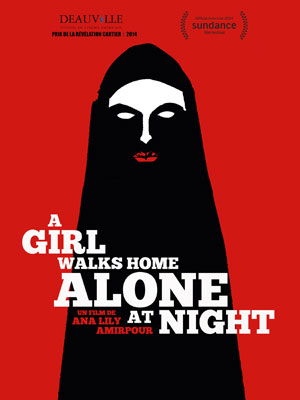Film: Jessica kellgren-Hayes
Independence
Brighton’s Duke of York’s cinema lays claim to being the oldest British cinema in continuous use and is today known for showing films that are a little ‘out there’- the kind of thing we wouldn’t be able to see anywhere else in the city. 
One recent showing was of Ana Lily Amirpour’s debut, A Girl Walks Home Alone At Night- the first Iranian, Vampire Western ever made! Obviously this is not a genre that looks to be brimming over with films any time soon but the film is a joyful mash-up. Full of stylised fragments that are prioritised over story and characters the film fails to compose a bigger picture but in its own way creates something far more beautiful instead.
Set in the fictional Iranian ghost town of Bad City (the name nodding towards Frank Miller’s graphic novel Sin City) and shot in crisp black-and-white, the film’s look exists in a twilight zone. Whilst it nods to the late 19th century’s ghost stories and early cinema, the film’s look also owes much to comic books and contemporary pop iconography. Iranian-American writer-director Amirpour describes the exhilarating film as the ‘Iranian love-child of Sergio Leone and David Lynch, with Nosferatu as a babysitter’.
You’ll note I have yet to mention the plot… largely because there isn’t one! A young man, handsome and well coiffed but a bit of a cad, is working hard to pay off his vintage convertible. Yet his father is a heroin addict with more debts than love for his son and the car is taken by a tattooed, drug-dealing pimp as collateral. Our hero is then placed at the scene of a murder but, with the authorities notable only for their absence, it is the lawless he truly has to fear.
This out of control town needs a saviour; the stranger with a murky past who wanders in and saves the day as in every Western before. What is unexpected is that this liberating angel should be a skateboarding, alienated, chador-wearing teenage girl! And possibly not entirely alive. The character shapeshifts as the film mutates around her, gleefully transforming to bask in the sheer pleasure of pulp.
With influences spanning spaghetti westerns, graphic novels, horror films and the Iranian New Wave, the film creates a complex, interwoven web of genre, archetype and iconography that at once seems also effortless. A subversive intelligence brings together oxymoronic elements that bridge between cinema’s history and its modern incarnation, with only a few strays into the tiresomely meta.
The film is at once a political parable and a lurid legend – either way, it’s sensational!
For more great films, check the listings for Latest TV’s film review show, PostFeature. Follow us @PostFeatureTV to find out when we’re on!




















